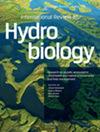Allelopathic activity of the bloom-forming picocyanobacterium Synechococcus sp. on the coexisting microalgae: The role of eutrophication
Abstract
Allelopathic picocyanobacteria have been responsible for harmful incidents with severe ecological impacts in many parts of the world. The allelopathic interactions that have been shown to be implied in the dominance of various species of phytoplankton, forming massive blooms, are influenced by environmental factors such as nutrient concentration. This study aims to determine in what extent the allelopathic activity of the bloom-forming picocyanobacterium Synechococcus sp. is impacted by water stoichiometry. We measured the allelopathic activity of Synechococcus sp. on growth, chlorophyll fluorescence, and photosynthetic performance of green algae Chlorella vulgaris and Oocystis submarina and diatoms Bacillaria paxillifer and Skeletonema marinoi by addition of cell-free filtrate obtained from cultures growing in nutrient-sufficient (NP), nitrogen-deficient (−N), or phosphorus-deficient (−P) culture medium. These studies indicated that sufficient amounts of nutrients affected the picocyanobacterium increasing its production of allelochemicals. Conversely, the weakest allelopathic activity was recorded after the addition of a filtrate obtained from Synechococcus sp. grown at −N medium. The highest decline in growth, the maximum quantum yield of photosystem II (PSII) photochemistry (Fv/Fm) and the photosynthetic capacity (Pm) were observed for diatom S. marinoi. On the other hand, Synechococcus sp. filtrate had no allelopathic effects on O. submarina. While confirming the allelopathic activity of Synechococcus sp. these findings show that production of allelopathic substances is influenced by the availability of nutrients.

 求助内容:
求助内容: 应助结果提醒方式:
应助结果提醒方式:


